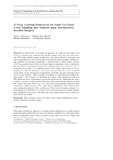| dc.contributor.author | Alhassan, Victor | |
| dc.contributor.author | Henry, Christopher | |
| dc.contributor.author | Ramanna, Sheela | |
| dc.contributor.author | Storie, Christopher | |
| dc.date.accessioned | 2019-08-01T21:04:17Z | |
| dc.date.available | 2019-08-01T21:04:17Z | |
| dc.date.issued | 2019-07-17 | |
| dc.identifier.citation | Alhassan, Victor, Christopher Henry, Sheela Ramanna, and Christopher Storie, "A Deep Learning Framework: Land-Use/Land-Cover Mapping and Analysis using Multispectral Satellite Imagery." Neural Computing and Applications (published online 17 July 2019). DOI: 10.1007/s00521-019-04349-9. | en_US |
| dc.identifier.issn | 0941-0643 | |
| dc.identifier.uri | http://hdl.handle.net/10680/1707 | |
| dc.description | Preprint version | en_US |
| dc.description.abstract | In this article, we present an approach to land-use and land-cover (LULC) mapping from multispectral satellite images using deep learning methods. The terms satellite image classification and map production, although used interchangeably have specific meanings in the field of remote sensing. Satellite image classification describes assignment of global labels to entire scenes, whereas LULC map production involves producing maps by assigning a class to each pixel. We show that by classifying each pixel in a satellite image into a number of LULC categories we are able to successfully produce LULC maps. This process of LULC mapping is achieved using deep neural networks pre-trained on the ImageNet large-scale visual recognition competition datasets and fine-tuned on our target dataset, which consists of Landsat 5/7 multispectral satellite images taken of the Province of Manitoba in Canada. This approach resulted in 88% global accuracy. Performance was further improved by considering the state-of-the-art generative adversarial architecture and context module integrated with the original networks. The result is an automated deep learning framework that can produce highly accurate LULC maps images significantly faster than current semi-automated methods. The contribution of this article includes extensive experimentation of different FCN architectures with extensions on a unique dataset, high classification accuracy of 90.46%, and a thorough analysis and accuracy assessment of our results. | en_US |
| dc.description.sponsorship | "This research has been supported by through a Queen Elizabeth II Diamond Jubilee scholarship and by the Natural Sciences and Engineering Research Council of Canada (NSERC) discovery Grants 194376 and 418413. Moreover, this work would not have been possible without the support and cooperation of GeoManitoba." | en_US |
| dc.description.uri | https://link.springer.com/article/10.1007/s00521-019-04349-9 | en_US |
| dc.language.iso | en | en_US |
| dc.publisher | Springer | en_US |
| dc.rights | info:eu-repo/semantics/openAccess | en_US |
| dc.subject | Deep learning | en_US |
| dc.subject | Land use | en_US |
| dc.subject | Land cover | en_US |
| dc.subject | Maps | en_US |
| dc.subject | Classification | en_US |
| dc.subject | Deep neural networks | en_US |
| dc.subject | Satellite images | en_US |
| dc.title | A Deep Learning Framework: Land-Use/Land-Cover Mapping and Analysis using Multispectral Satellite Imagery | en_US |
| dc.type | Article | en_US |
| dc.identifier.doi | 10.1007/s00521-019-04349-9 | en_US |

